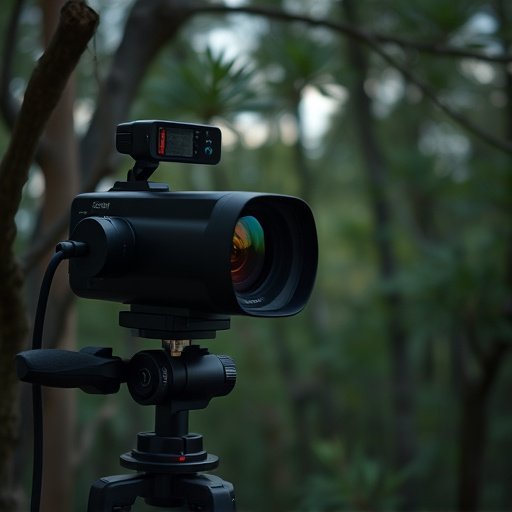Tiny cameras for home monitoring have revolutionized personal security with discreet yet powerful surveillance solutions. These compact devices offer high-resolution footage, night vision, and wireless connectivity, allowing remote monitoring via smartphone apps or software. RF detectors are crucial for detecting these hidden cameras, offering a reliable method to identify covert signals in homes and offices. Effective use involves maintaining equipment, strategic camera placement, systematic sweeps, and documenting any signals. Beginners should avoid assuming visual glitches and stay informed about diverse concealment techniques to reduce false positives.
Uncover hidden threats with a detailed guide on detecting tiny cameras for home monitoring using RF detector sweeps. Learn how these compact, yet powerful devices can compromise your privacy and discover practical steps for a successful sweep. From understanding the technology behind them to avoiding common mistakes, this tutorial equips you with the knowledge to safeguard your home environment.
- Understanding Tiny Cameras for Home Monitoring
- Detecting Hidden Cameras with RF Sweeps
- Practical Steps for a Successful RF Detector Sweep
- Common Mistakes to Avoid During the Process
Understanding Tiny Cameras for Home Monitoring
Tiny cameras for home monitoring have revolutionized personal security, offering discreet and effective surveillance solutions. These compact devices are designed to blend seamlessly into various environments, from subtle ceiling mounts to hidden corners, ensuring round-the-clock observation without compromising aesthetics. With advanced technology, they capture high-resolution footage, often with night vision capabilities, providing clear images even in low-light conditions.
Unlike traditional cameras, tiny cameras for home monitoring are designed to be virtually invisible, making them an attractive option for homeowners seeking robust security without visible equipment. Their lightweight nature and wireless connectivity options make installation quick and hassle-free, allowing users to monitor their properties from anywhere using smartphone apps or computer software. This advanced functionality ensures peace of mind while enhancing safety measures.
Detecting Hidden Cameras with RF Sweeps
Detecting hidden cameras, especially tiny cameras for home monitoring, has become an essential skill in today’s privacy-conscious world. Radio Frequency (RF) detector sweeps offer a powerful tool for achieving this. These devices operate by scanning through various RF bands to pick up signals that could indicate the presence of covert surveillance equipment.
By using RF sweeps, individuals can proactively search for hidden cameras and other tracking devices. This method is particularly effective in high-risk areas like homes, offices, or public spaces where tiny cameras might be discreetly installed. The process involves setting up the detector and meticulously scanning rooms or zones to identify any unusual or unauthorized signals, ensuring a safer and more private environment.
Practical Steps for a Successful RF Detector Sweep
For a successful RF (Radio Frequency) detector sweep, follow these practical steps tailored for those using tiny cameras for home monitoring. First, ensure your equipment—a reliable RF detector and miniature hidden cameras—is in optimal condition. Calibrate your detector according to the manufacturer’s instructions to guarantee accurate readings. Position your cameras strategically within the area you wish to monitor, ensuring they are discreetly placed but capture clear images or video.
Next, conduct a systematic sweep by moving methodically through the space being monitored. As you traverse each section, activate your RF detector and observe the readings. Any sudden spikes or consistent signals could indicate active hidden cameras. Document these findings thoroughly, noting signal strengths and locations for further investigation. Regular maintenance and practice will enhance your sweep efficiency, providing a secure environment with minimal intrusion using tiny cameras for home monitoring.
Common Mistakes to Avoid During the Process
When detecting hidden cameras, especially tiny cameras for home monitoring, beginners often fall into a few traps that can compromise the search or yield false positives. One common mistake is assuming that every visual glitch or peculiarity is a camera. Many everyday objects reflect light in unique ways, and what seems like a suspicious device could be a harmless remote control or even a reflection from a window. Taking a moment to observe and eliminate these possibilities before diving deeper saves time and reduces anxiety.
Another blunder is failing to account for the entire spectrum of hidden camera types. Modern tiny cameras are sophisticated and can operate wirelessly, making them hard to detect with traditional methods alone. It’s crucial to be aware of various concealment techniques and stay updated on the latest technology to avoid overlooking these concealed devices during your sweep.
Tiny cameras for home monitoring have become increasingly sophisticated, but detecting them requires a vigilant approach. Using radio frequency (RF) detector sweeps is an effective method to uncover hidden cameras, ensuring your privacy and peace of mind. By following the practical steps outlined in this tutorial, you can successfully navigate the process and stay one step ahead of potential intruders. Remember, staying informed about these advanced surveillance techniques is key to protecting your personal space.
